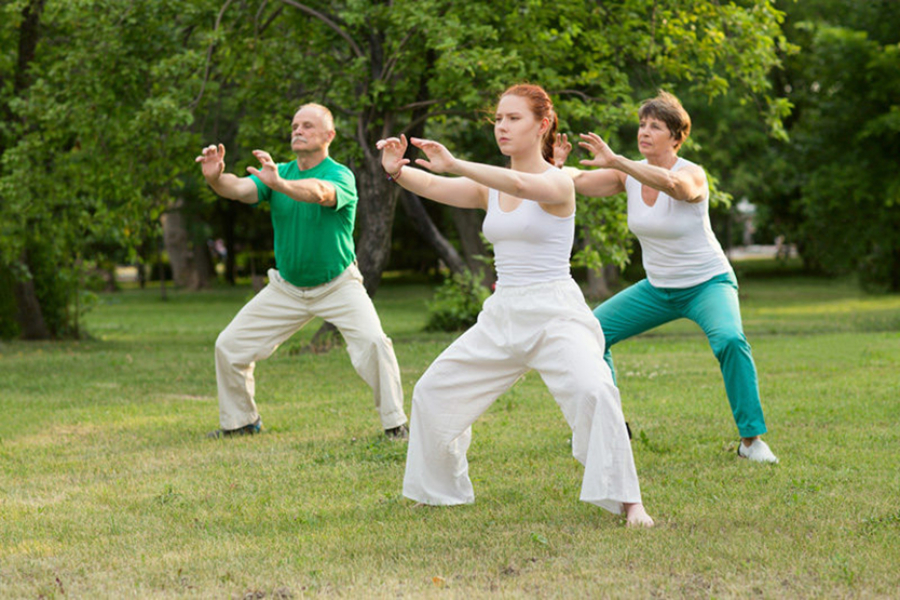Introduction
In our fast-paced modern world, the pursuit of holistic health and well-being has gained remarkable momentum. As we delve deeper into ancient practices that bridge the gap between the mind and body, traditional techniques like qigong and tai chi have come into the limelight. These age-old Chinese practices offer a unique blend of physical movement, mindfulness, and deep-rooted philosophy. In this article, we’ll take an in-depth journey into the realms of qigong and tai chi, exploring their distinctive attributes, with a focus on qigong’s remarkable impact on physical and mental health.
In the search for wellness that touches both our bodies and our minds, the allure of qigong and tai chi has grown immensely. These practices have become more than just exercises; they’re gateways to cultivating an inner sense of balance and vitality. We’ll navigate through the intricate paths of qigong and tai chi, deciphering the nuances that set them apart, while shedding light on the myriad ways qigong can positively influence our physical and mental well-being.
Join us as we uncover the secrets of qigong’s gentle yet profound movements, its calming influence on stress and anxiety, and its potential to enhance our immune systems. We’ll also explore how qigong serves as an avenue to connect our bodies and minds, nurturing a harmony that can lead to improved overall health. Whether you’re a newcomer to these practices or already well-acquainted, this exploration promises to offer fresh insights into the world of qigong and its exceptional contributions to our holistic journey toward well-being.
Qigong vs. Tai Chi: Understanding the Differences
In the realm of mind-body practices, qigong and tai chi often find themselves mentioned together. While they share roots in ancient Chinese traditions and offer a range of health benefits, they are distinct in their focus and execution. Let’s delve into the intricacies that set qigong and tai chi apart, helping you gain a clearer understanding of these practices.
Qigong: The Art of Cultivating Energy
Qigong, pronounced “chee-gong,” is a practice deeply rooted in the idea of cultivating and balancing the body’s vital life force energy, known as “qi” or “chi.” At its core, qigong involves a series of slow and deliberate movements combined with mindful breathing techniques. These movements are designed to promote the flow of qi throughout the body’s energy pathways, known as meridians. Qigong encompasses a diverse range of styles and forms, each with its own set of movements and intentions.
Tai Chi: The Dance of Yin and Yang
Tai chi, often referred to as “moving meditation,” is a martial art that also has its origins in ancient China. Tai chi emphasizes the harmony of yin and yang, the two fundamental forces in the universe. It involves a sequence of flowing movements and postures performed in a slow, graceful manner. While tai chi shares similarities with qigong, its movements are often more structured and connected, resembling a fluid dance. Tai chi forms can vary widely, from traditional to modern adaptations, each focusing on cultivating balance, flexibility, and strength.
While both qigong and tai chi incorporate elements of mindfulness, breath control, and gentle movement, their primary objectives and forms of practice set them apart. Qigong leans towards cultivating energy and balancing qi, while tai chi emphasizes the integration of mind, body, and spirit through the embodiment of yin and yang principles.
In the next sections, we’ll uncover the specific physical and mental health benefits that qigong offers, shedding light on why it has become a popular practice for those seeking holistic well-being. So, whether you’re intrigued by qigong’s energy cultivation or tai chi’s graceful dance, stay with us as we delve into the remarkable world of qigong’s impact on health and wellness.

Qigong’s Physical Health Benefits
The practice of qigong transcends the realm of mere physical exercise. Its harmonious blend of movement, breath, and intention gives rise to a wealth of benefits that contribute to overall well-being. Let’s explore how qigong can positively impact your physical health:
Lowering Blood Pressure:
Hypertension, or high blood pressure, is a prevalent health concern that can lead to serious cardiovascular issues. Research suggests that qigong may hold the potential to help manage blood pressure levels. Through its intentional breathwork and focus on energy flow, qigong encourages relaxation and activates the parasympathetic nervous system. This response, in turn, leads to a reduction in heart rate and blood pressure. Studies have shown that qigong might be as effective as conventional exercise routines in regulating blood pressure.
Relieving Chronic Pain:
For individuals grappling with chronic pain conditions, qigong offers a gentle and effective approach to pain management. The slow and controlled movements of qigong stimulate circulation and promote the flow of qi through the body’s meridians. By introducing gentle movement to tight muscles and joints, qigong helps alleviate tension and reduce discomfort. It’s particularly beneficial for conditions like osteoarthritis and low back pain, where movement is often restricted due to pain.
Strengthening the Immune System:
The deliberate and fluid movements of qigong have been linked to improved immune system function. By enhancing the circulation of essential fluids like blood, lymph, and synovial fluid, qigong supports the body’s immune response. Studies have indicated that regular qigong practice may lead to increased levels of immune cells and improved regulation of inflammation-related hormones. These immune-boosting effects can contribute to a stronger overall defense against illnesses.
Improving Fitness:
Qigong is a form of exercise that transcends age and fitness levels. Its low-impact nature makes it accessible to a wide range of individuals, including those with limited mobility. Qigong’s gentle aerobic and strength components contribute to improved physical fitness, including balance, flexibility, and strength. Different qigong styles offer variations in movements and intensity, allowing practitioners to tailor their practice to their specific needs and goals.
In the following section, we’ll delve into the realm of qigong’s impact on mental health. From alleviating anxiety and stress to fostering an overall sense of well-being, qigong’s holistic approach reaches beyond the physical, nurturing a deeper connection between the mind and body. Join us as we explore the profound ways in which qigong can enrich your mental landscape.
Qigong’s Mental Health Benefits
Beyond its tangible physical advantages, qigong holds a profound influence on the realm of mental health and emotional well-being. This ancient practice offers a sanctuary for the mind, inviting tranquility and balance into our busy lives. Let’s explore how qigong can positively impact your mental health:
Reducing Anxiety and Stress:
In a world marked by constant demands and pressures, qigong serves as a sanctuary for finding inner calm. The deliberate and slow movements, coupled with focused breathing, create a space of mindfulness and presence. This deliberate attention to the present moment helps alleviate anxiety and stress. The rhythmic flow of qigong movements triggers the activation of the parasympathetic nervous system, promoting relaxation and countering the fight-or-flight response.
Alleviating Depression:
Qigong’s influence on mental health extends to the realm of depression. Studies have indicated that qigong’s ability to activate the parasympathetic nervous system can have a positive impact on depressive symptoms. By calming the sympathetic nervous system, qigong helps regulate immune responses that are tangentially related to depression. The practice’s emphasis on the mind-body connection also contributes to a sense of well-being, offering a potential avenue for managing and alleviating depressive feelings.
Enhancing Overall Well-Being:
Qigong is more than a physical practice; it’s an opportunity to forge a deeper connection between the mind, body, and spirit. The intentional movements and mindful presence inherent in qigong foster a holistic sense of well-being. As you engage in the practice, you’ll discover a profound integration of physical sensations, mental clarity, and emotional balance. This synergy between different aspects of yourself creates a harmonious state that transcends the boundaries of the practice session, enriching your daily life.
As we continue our exploration, we’ll guide you through the process of embarking on a qigong journey, even if you’re a complete beginner. From selecting the right qigong style to establishing a practice routine, we’re here to help you take your first steps toward cultivating a healthier and more balanced life. Join us in the upcoming section to uncover the practical insights you need to start your qigong practice on the right foot.

Getting Started with Qigong: A Guide for Beginners
Embarking on a journey into qigong is a step toward discovering a world of holistic well-being and inner harmony. Whether you’re new to mind-body practices or seeking a new avenue for wellness, starting your qigong journey is an exciting endeavor. Here’s a comprehensive guide to help you get started:
Choosing the Right Qigong Style:
Qigong offers a diverse array of styles, each with its own philosophy and movements. Before you begin, take some time to explore different qigong styles and find the one that resonates with you. Some styles emphasize energy cultivation, while others focus on specific health benefits. Whether it’s the graceful movements of “Eight Pieces of Brocade” or the meditative stillness of “Zhan Zhuang,” choose a style that aligns with your goals and preferences.
Setting Up a Practice Routine:
Consistency is key in qigong practice. Establish a routine that suits your schedule and commitments. Decide on the frequency of your practice sessions, whether it’s daily or a few times a week. Set aside a dedicated space for your practice, free from distractions. It can be indoors or outdoors, as long as it’s a tranquil and comfortable environment.
Starting with Basic Movements:
As a beginner, start with simple and foundational qigong movements. These movements are designed to introduce you to the principles of qigong and help you build a strong foundation. Focus on your breath, posture, and the mindful execution of each movement. As you become more comfortable, you can gradually incorporate more complex movements into your practice.
Breathwork Techniques:
Breath is an integral part of qigong practice. Learn to synchronize your breath with your movements, allowing it to guide your practice. Practice deep and intentional breathing, inhaling through the nose and exhaling through the mouth. Pay attention to the way your breath flows through your body, enhancing your awareness of the mind-body connection.
Gradual Progression:
Qigong is a journey of self-discovery and growth. Approach your practice with patience and a willingness to learn. Avoid pushing yourself too hard in the beginning; instead, focus on gradual progression. As your body becomes more accustomed to the movements and breathwork, you can explore more advanced techniques and longer practice sessions.
Remember that qigong is a personal journey, and there’s no one-size-fits-all approach. Listen to your body and respect its limits. As you continue your qigong practice, you’ll uncover the unique benefits it brings to your physical and mental well-being. In the next section, we’ll explore the unique advantages of qigong over its counterpart, tai chi, helping you make an informed decision about which practice aligns with your goals. Join us in this exploration of qigong vs. tai chi and their distinctive contributions to holistic health.
Qigong vs. Tai Chi: Which One to Choose?
As you journey deeper into the world of mind-body practices, you might find yourself contemplating whether to embrace qigong or tai chi. Both practices offer remarkable benefits for physical and mental well-being, yet their approaches and outcomes vary. Here, we’ll explore the unique attributes of each practice to help you make an informed choice:
Qigong: The Path of Energy Cultivation
Qigong’s primary focus lies in cultivating and balancing the body’s vital life force energy, qi. Through deliberate movements, breathwork, and mindfulness, qigong facilitates the flow of energy throughout the body’s meridians. This practice is particularly effective in promoting relaxation, reducing stress, and enhancing the mind-body connection. Qigong’s emphasis on intentional breathwork and gentle movements creates a holistic experience that benefits both physical and mental health.
Tai Chi: The Dance of Harmony
Tai chi, often referred to as a “moving meditation,” embraces the principles of yin and yang, seeking harmony between opposing forces. While also encompassing movement, breath, and mindfulness, tai chi’s structured sequences are more dynamic and resemble a graceful dance. Tai chi enhances balance, flexibility, and strength while promoting inner tranquility. It’s especially effective for those seeking a practice that integrates mindfulness with physical movement.
Which One to Choose?
The decision between qigong and tai chi ultimately depends on your personal goals and preferences. If you’re drawn to energy cultivation, a focus on relaxation, and a gentler approach, qigong might resonate with you. On the other hand, if you’re intrigued by the idea of graceful movements that foster balance and harmony, tai chi could be your choice.
Keep in mind that both qigong and tai chi offer holistic benefits that extend beyond the physical. Whichever path you choose, the journey toward improved well-being and a deeper connection between your mind and body awaits. It’s also worth noting that you’re not limited to just one practice; you can explore both qigong and tai chi to see which aligns best with your unique needs and preferences.
In Conclusion, the world of qigong and tai chi holds a wealth of treasures for those seeking a harmonious balance between physical health and mental well-being. Whether you’re drawn to qigong’s energy cultivation or tai chi’s dance of harmony, both practices offer pathways to a more enriched and fulfilling life. The journey into these ancient practices is a journey toward self-discovery, resilience, and a profound connection to the rhythms of your own existence.

Conclusion
In the intricate tapestry of holistic well-being, qigong emerges as a radiant thread that weaves together the realms of physical and mental health. This ancient practice, rooted in the philosophy of energy cultivation and mindfulness, offers a gateway to profound transformation. As we close this exploration of qigong’s remarkable benefits, let’s reflect on the journey we’ve embarked upon.
Qigong’s gentle movements, intentional breathwork, and mindfulness invite us to step into a realm of balance and vitality. Its ability to lower blood pressure, alleviate chronic pain, and strengthen the immune system speaks to its remarkable impact on our physical health. Equally captivating is qigong’s influence on our mental landscape—it has the power to reduce anxiety and stress, alleviate depression, and foster a sense of overall well-being.
For those ready to embark on their qigong journey, our guide for beginners provides essential insights into starting this transformative practice. From selecting the right style to establishing a practice routine, you’re equipped with the tools to step onto the path of self-discovery and growth.
In the world of mind-body practices, the choice between qigong and tai chi beckons us to explore our individual inclinations. As you contemplate your choice, remember that the journey toward well-being is deeply personal. Whether you choose qigong’s energy cultivation or tai chi’s graceful dance, the path you embark upon is one that offers a bridge to the harmony of mind, body, and spirit.
So, as you step into the world of qigong, may you find solace in its deliberate movements, wisdom in its breath, and serenity in its stillness. Whether you’re embracing qigong for its physical health benefits, its impact on mental well-being, or the profound synthesis of the two, know that this practice holds the potential to enrich every facet of your life. Embrace the journey with an open heart, for within the realm of qigong lies a treasure trove of vitality, serenity, and boundless well-being.
***
If you’ve found this exploration of qigong’s benefits intriguing and are eager to delve deeper into the practice, you might be interested in discovering firsthand experiences. To further satisfy your curiosity, consider exploring reviews about “Unlocking the Ancient Secrets of Qigong with Grandmaster Jiang Yu Shan’s Health & Fighting Qigong 2023 Course.” These reviews provide insights from individuals who have embarked on this transformative journey, offering a glimpse into the tangible and profound effects of practicing qigong under the guidance of an esteemed expert. Delve into the experiences shared by fellow practitioners to gain a well-rounded understanding of the course’s impact on physical health, mental well-being, and overall quality of life. These reviews can serve as a valuable resource to inform your decision and inspire you to embark on your own path of qigong discovery.


